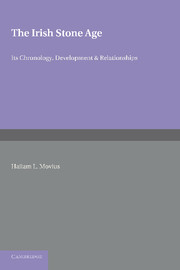Book contents
- Frontmatter
- Dedication
- Contents
- ILLUSTRATIONS
- FOREWORD
- PREFACE
- INTRODUCTION
- Part One THE CHRONOLOGY OF THE LATE-GLACIAL AND EARLY POST-GLACIAL PERIODS IN NORTHERN AND WESTERN EUROPE
- Part Two THE STONE AGE CULTURES OF IRELAND
- CHAPTER I The Antiquity of Man in Ireland
- CHAPTER II The Mesolithic Culture of the Irish Raised Beaches
- CHAPTER III The Origin and Affinities of the Larnian Culture
- CHAPTER IV Post-Larnian Developments
- CHAPTER V Conclusions
- Appendices I-VI
- REFERENCES CITED IN THE TEXT
- CLASSIFIED LIST OF REFERENCES TO CAVE RESEARCH AND STONE AGE ARCHAEOLOGY IN IRELAND
- ADDENDUM
- INDEX
CHAPTER III - The Origin and Affinities of the Larnian Culture
from Part Two - THE STONE AGE CULTURES OF IRELAND
Published online by Cambridge University Press: 05 June 2016
- Frontmatter
- Dedication
- Contents
- ILLUSTRATIONS
- FOREWORD
- PREFACE
- INTRODUCTION
- Part One THE CHRONOLOGY OF THE LATE-GLACIAL AND EARLY POST-GLACIAL PERIODS IN NORTHERN AND WESTERN EUROPE
- Part Two THE STONE AGE CULTURES OF IRELAND
- CHAPTER I The Antiquity of Man in Ireland
- CHAPTER II The Mesolithic Culture of the Irish Raised Beaches
- CHAPTER III The Origin and Affinities of the Larnian Culture
- CHAPTER IV Post-Larnian Developments
- CHAPTER V Conclusions
- Appendices I-VI
- REFERENCES CITED IN THE TEXT
- CLASSIFIED LIST OF REFERENCES TO CAVE RESEARCH AND STONE AGE ARCHAEOLOGY IN IRELAND
- ADDENDUM
- INDEX
Summary
INTRODUCTION
The final retreat of the last ice-sheet and the rapid spread of the Early Post-Glacial forests came at a period when the culturally homogeneous North European Plain extended as far as England, then separated from Ireland by only a narrow arm of the sea, the Irish Channel River. The Upper Palaeolithic settlers from Creswell Crags and other sites in Southern Britain began to move north and west and a new Mesolithic culture, the Larnian, was developed. This movement had already reached Scotland in Late- Glacial times, as suggested by the occupation layers in the caves near Inchnadamff, Sutherland, and by the flake implement found near Comrie, Perthshire, previously described (see pp. 48 and 71-3). Present evidence, however, does not indicate that Ireland was permanently settled until Mesolithic times. Sporadic hunting parties may have crossed on the ice or on former land-bridges at an earlier period, but there is no proof as yet that this occurred. As the name implies, the Larnian was centred in North-East Ireland. Here it is richly represented, especially on the coast, where the flint supply is almost inexhaustible, and to trace its development an understanding of environmental factors is necessary. Typologically the Early Larnian, which corresponds to Dr Clark's Period II (1936, p. 31), is much closer to the Creswellian (Upper Palaeolithic) of Britain than is its descendant, the Late Larnian, of Clark's Period III, a fact which reflects geographical conditions. At best timber was always scarce in the steppe-tundra country of the Late Glacial Period, hence woodworking tools are rare in cultures which flourished under the prevailing Arctic-Alpine conditions. As the climate became more equable, however, heavy implements were evolved, and the steep or core scrapers of the Early Larnian possibly represent early forms of adzes. Later as the forests increased there is a noticeable tendency towards larger and heavier implements; the approach of the climatic optimum is reflected in the Late Larnian by the occurrence of massive tools which are presumably woodworking implements.
It seems very likely that the inundation by the sea of huge tracts of land was directly responsible for a complete reorganization of the mode of life. From an economy apparently based on forest hunting activities, a coastal type of existence seems to have been adopted.
- Type
- Chapter
- Information
- The Irish Stone AgeIts Chronology, Development and Relationships, pp. 175 - 210Publisher: Cambridge University PressPrint publication year: 2013



